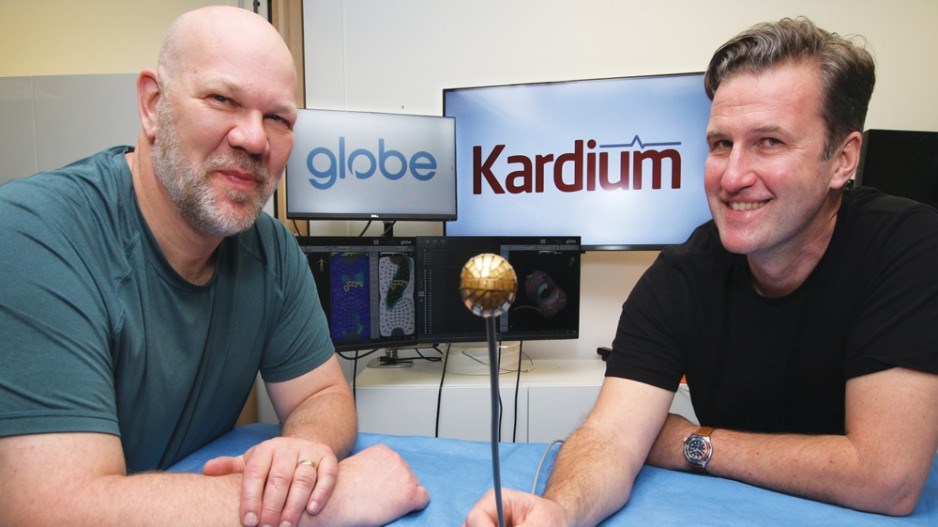September often means Labour Day barbecues, back-to-school shopping for the kids and final visits to restaurant patios before the heat lamps come out for fall.
But in 2020, Kevin Chaplin spent half that month quarantining in his basement after a business trip to Germany, where his B.C. medical device company was deploying its flagship product for the first time since getting the nod from European Union (EU) regulators.
Flash forward 18 months and the CEO of Kardium Inc. can now take a short drive to St. Paul’s Hospital in Vancouver to see how the first clinical trials in North America are unfolding for the devices treating atrial fibrillation (an irregular heartbeat).
“For our employees it feels really tangible that we’re using it on our home turf,” Chaplin said.
“The fact that we have it now in Vancouver, it’s going to allow our engineers and clinical team just easier access to working with physicians and doctors without having to travel internationally to see clinical use of the system.”
With CE certification secured in the EU, clinical trials underway in Canada and testing set to begin early next year at 20 clinical sites in the U.S., Kardium’s commercialization journey is in full ramp-up mode after 15 years of development.
The company raised US$115 million from investors last year and should the U.S. Food and Drug Administration approve Kardium’s Globe Mapping and Ablation system, Chaplin said he plans to raise more investor dollars through an initial public offering.
Kardium’s devices are about one metre long and feature a handle at one end to control them and a catheter with an array of electrodes at the other end.
The catheter is inserted into the femoral vein via a needle in the patient’s groin area, and the device’s electrodes travel up to the heart. The electrodes map the heart’s activity and then burn tissue inside to create scarring, stopping the bad electric signals and returning the heart to its normal rhythm.
Current systems feature one electrode. Kardium’s has 122 electrodes, which can reduce the process to about one hour from four.
Equipment used for traditional procedures costs about US$8,000 to US$12,000 per procedure, while Kardium’s costs for its single-use device are comparable to that.
Because of the device’s complexity, Chaplin and a small team had to travel to Germany just months into the pandemic to assist with training doctors and nurses of the newly certified system.
Manufacturing is done in Burnaby, where the company recently secured another 66,000 square feet of office and industrial space on top of the 58,000 square feet it occupies at the same business park.
“There’s a recognition from both provincial and federal governments, and a lot of companies here that Vancouver and the Lower Mainland can really become a biotech, medical or health-care hub. And I think that’s part of why we’re excited to work with St. Paul’s,” Chaplin said. “As we continue development of the system and testing of the system, it just gives us additional access to doctors. It’s really important to see how different doctors use the … system differently.”
B.C.’s life science sector generated $5.4 billion in revenue in 2018, according to the latest data from the provincial government.
That’s up 5.6 per cent compared with the prior year – long before the pandemic brought widespread attention to Vancouver biotech firm AbCellera Biologics Inc. (Nasdaq:ABCL) or Victoria-based medical device manufacturer StarFish Medical Inc.
Chaplin said the goal for Kardium, which employs around 200 in B.C., is to become one of the province’s next anchor companies. He expects to hire another 250 workers over the next two to three years.
A labour market report from BioTalent Canada last year projected a national shortage of 65,000 life sciences workers by 2029. And about 5,000 of those unoccupied jobs will be in Vancouver, according to CEO Rob Henderson.
Chaplin said Kardium often hires workers without direct experience in medical device manufacturing and then doubles down on training.
“For us it’s often difficult to find the exact skillset. There’s not a lot of medical device manufacturers in Vancouver,” he said.
“It is a long road to commercialization. The fact that we’ve tested and used the system commercially in Europe, and we’re now bringing it to North America, it’s really significant.” •




